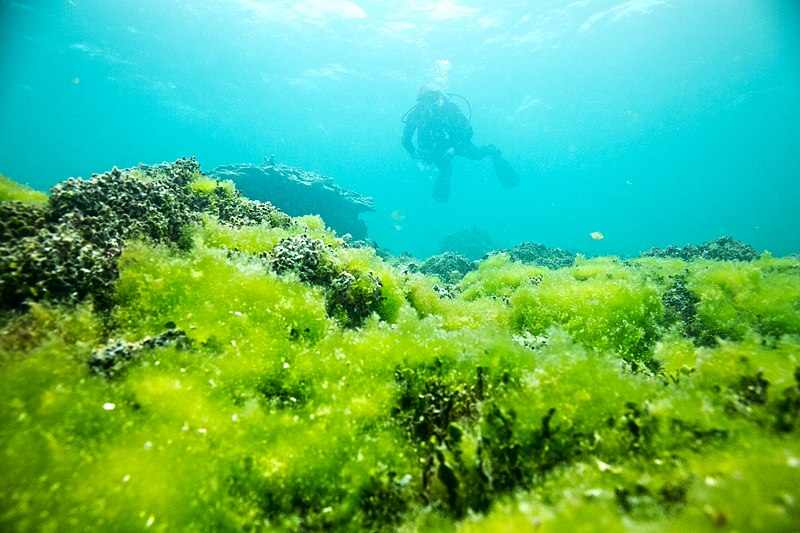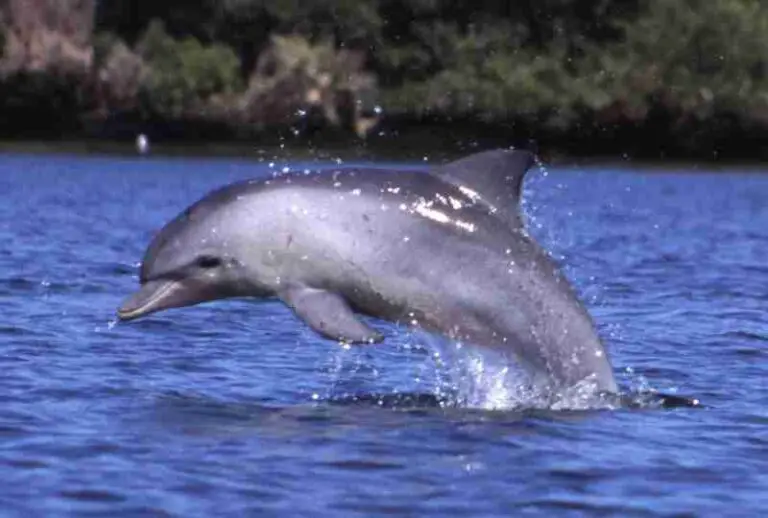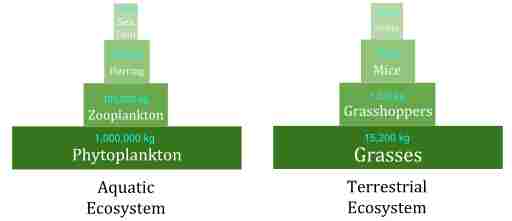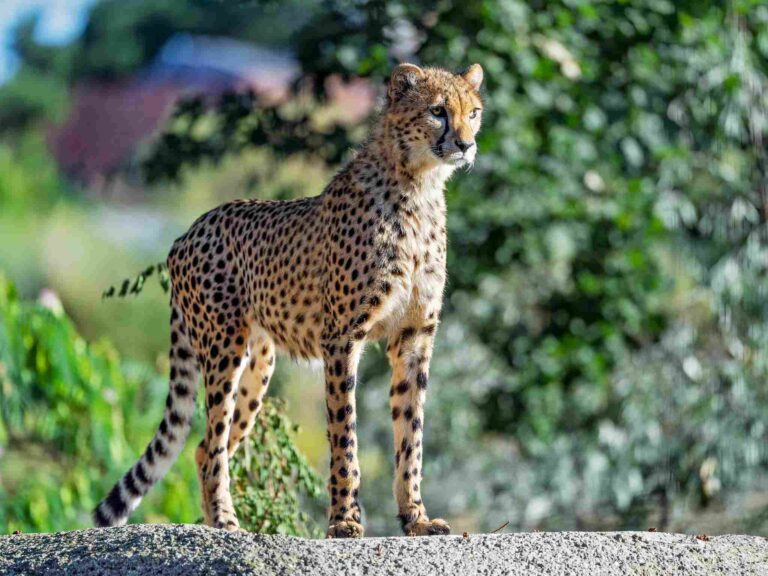5 Biotic Factors in the Coral Reef Ecosystem Discussed
Biotic factors in the coral reef ecosystem are; reef-producers, herbivorous, carnivorous and omnivorous consumers, as well as reef-decomposers.
It must be noted that coral reefs are not always considered to be ecosystems, but in some cases could be viewed as micro-ecosystems because they fall within marine ecosystems, or oceans.
This article discusses biotic factors in the coral reef ecosystem, as follows;
1). Coral Reef-Producers (as one of the Biotic Factors in the Coral Reef Ecosystem)
Producers in the coral reef ecosystem are organisms that are autotrophic, and can manufacture their own food using visible light from the Sun, and inorganic materials like carbon dioxide (CO2) and water [4].
Being the primary producers of biomass and bioenergy, these organisms occupy the basal trophic level of the food chain and energy pyramid of coral reefs.
There are about three main groups of primary producers in the coral reef, namely; microalgae (also called phytoplankton), macroalgae, and polyps.
Microalgae or phytoplankton are arguably the most well-known and popular coral reef producers. They occur as free-floating, single-celled autotrophs, with high levels of species richness and biodiversity [3].
Examples of phytoplankton in coral reefs include; cyanobacteria and dinoflagellates.
Marcoalgae are biologically similar to microalgae, but have smaller, microscopic dimensions. They may also be referred to as seaweeds, and include red algae (Rhodophyta), green algae (Chlorophyta), and brown algae (Phaeophyta).
It must be noted that these producers are not always core inhabitants of coral reefs, or restricted to reef habitats. Rather, they can occur around reef areas and intertidal zones, sometimes occurring on the onshore-coastal margin.
In coral reefs, macroalgae serve as micro-habitats for some fish and small zooplankton. This is in addition to their being a food source. However, their relatively-large size and high growth-rate imply that they can take up space and nutrients to an extent that could be problematic in some cases.
Coral polyps are sometime described as being semi-autotrophic, because their photosynthetic activity is carried out by zooxanthellae; an algae with which they occur in symbiotic unison [2].
Energy and nutrients provided by the zooxanthellae are supplied to polyps for their survival. Due to their colonial growth-patterns, polyps are primarily responsible for the building of reef structures.
The diversity of primary producers is a major driver of ecologic robustness in coral reefs. These producers for micro-habitats, while providing food and modifying the physicochemical conditions of reefs.

2). Coral Reef-Herbivorous Consumers
Herbivorous organisms, or primary consumers, in the coral reef, survive by feeding primarily on autotrophic marine organisms like microalgae.
Reef primary consumers contribute to the balance and ecological equilibrium of their environment by regulating the growth and mass of seaweeds and algae, so that these autotrophs do not grow to unsustainable levels.
The main groups herbivorous primary consumers in coral reefs are; sea slugs, urchins, and herbivorous fish.
Sea slugs are gastropods that are highly diverse in physiology, behavior, and areal distribution.
Some of them can be found in coral reefs, where they rely heavily on algae as a food source.
Sea urchins are herbivores with specially-adapted feeding structures called the Aristotle's lantern [1], for the purpose of grazing on algae-covered surfaces. They can be particularly dominant primary consumers in cases where larger herbivores are not prominently represented.
Parrotfish and rabbitfish are examples of herbivorous fish that can be found in the coral reef. These fish generally differ from carnivorous species in details of their dental, oral and gastric characteristics, which are adapted for the consumption of autotrophs like algae.
3). Coral Reef-Carnivorous Consumers (as one of the Biotic Factors in the Coral Reef Ecosystem)
Carnivores in the coral reef are organisms that survive by preying on other consumers, especially the herbivores.
Reef carnivores may occupy any of various trophic levels of the ecosystem, although a great proportion, of the population of these organisms are secondary consumers.
Food for coral reef carnivores consists of invertebrates and small fish.
Some examples of carnivorous consumers in the coral reef ecosystem are; eels, crustaceans, cone snails and octopuses.
The feeding adaptations of thee carnivores are very diverse, and indicate the diversity of conditions in the ocean (which facilitated these adaptations).
For example, cone snails immobilize prey with venomous stinging organelles [5], while eels depend on their large mouths and sharp teeth to capture prey.
Carnivores are essential to the coral reef ecosystem, and play a key role in energy-transfer from herbivorous consumers to organisms in higher trophic levels.
4). Coral Reef-Omnivores
Some consumers in the coral reef ecosystem, exhibit both herbivorous and carnivorous feeding habits. These organisms are omnivorous consumers, and are at the advantage of having a wide range of food choices that include animal and plant matter.
Omnivores in the coral reef are highly-adaptive feeders, and this makes them resilient with regards to events of food-resource depletion, especially when they are compared to other marine animals.
The ability to consume both plant and animal matter is a learned adaptation that can be driven by constraints in food supply. As a result, it is not uncommon for some reef organisms typically identified as herbivores or carnivores, to occasionally exhibit herbivorous tendencies.
Consumers in the coral reef that are omnivorous include; racoon butterflyfish, reef triggerfish, angelfish, and moorish idol.
These organisms may consume small crustaceans like shrimp, as well as smaller fish, and algae.
Typical herbivores like parrotfish may also exhibit omnivorous feeding behavior, especially under constrained ecologic conditions.
5). Coral Reef-Decomposers (as one of the Biotic Factors in the Coral Reef Ecosystem)
Decomposers in the coral reef are organisms whose feeding activities lead to the recycling of nutrients and breakdown of organic matter.
These organisms feed on waste from other biotic factors in the coral reef, including organic remains and metabolic byproducts.
Types of decomposers that live in coral reefs are; microbial decomposers, and detrivorous (invertebrate) organisms.
Five (5) examples of coral reef decomposers (including detrivores) are;
1. Shrimp
2. Fungi
3. Bacteria
4. Polychaete worm
5. Sea cucumber
These organisms are all involved in the biodegradation processes occurring in coral reefs.
They contribute in diverse ways to the breakdown of organic matter. Microbial organisms like bacteria and fungi break down biomass through enzymatic activities that convert the complex organic substrate into simpler elements and compounds that are ingested by the microbe as nutrients.
Crustaceans like shrimps, and other macroscopic invertebrates like polychaete worm and sea cucumber, break down organic matter through their detrivorous feeding activities that include masticating on detritus.

Conclusion
Biotic factors in the coral reef are;
1. Coral Reef-Producers
2. Coral Reef-Herbivorous Consumers
3. Coral Reef-Carnivorous Consumers
4. Coral Reef-Omnivores
5. Coral Reef-Decomposers
References
1). Beck, G. (2020). "Diagnostic Methods for the Comprehensive Health Assessment of the Long-Spined Sea Urchin, Diadema antillarum." Available at: https://www.researchgate.net/publication/342716045_Diagnostic_Methods_for_the_Comprehensive_Health_Assessment_of_the_Long-Spined_Sea_Urchin_Diadema_antillarum. (Accessed 27 May 2023).
2). Björn, L. O.; Ekelund, N. (2006). "Corals and zooxanthellae - A marine partnership." Svensk Botanisk Tidskrift 100(4):263-270. Available at: https://www.researchgate.net/publication/287073996_Corals_and_zooxanthellae_-_A_marine_partnership. (Accessed 27 May 2023).
3). Najmi, N.; Suriani, M.; Umar, T.; Mira, M. R.; Darmarini, A. S. (2022). "Diversity of marine plankton in coral reef ecosystems at Gosong Island, Southwest Aceh." E3S Web of Conferences 339(1):03004. Available at: https://doi.org/10.1051/e3sconf/202233903004. (Accessed 27 May 2023).
4). Roth, M. S. (2014). "The engine of the reef: photobiology of the coral-algal symbiosis." Front Microbiol. 2014 Aug 22;5:422. Available at: https://doi.org/10.3389/fmicb.2014.00422. (Accessed 27 May 2023).
5). Schendel, V.; Rash, L. D.; Jenner, R. A.; Undheim, E. A. B. (2019). "The Diversity of Venom: The Importance of Behavior and Venom System Morphology in Understanding Its Ecology and Evolution." Toxins (Basel). 2019 Nov 14;11(11):666. Available at: https://doi.org/10.3390/toxins11110666. (Accessed 27 May 2023).




